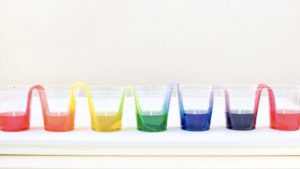2 Walking Water
Audrey Coop; Angelena Lara; and Camille Pushman
Walking Water

Age Group: 8- 12 years old
Keywords: Capillary action, dye, water, biology
Brief Description:
Water. It’s everywhere around us! From the snow outside to the great blue oceans, to your own kitchen. Since water is everywhere, we know lots of really cool things about it. This experiment shows the effect of capillary action (cap-il-lary), which is water’s ability to flow into narrow spaces.
In this experiment, we can observe capillary action through food dye, as it travels up through a paper towel and into the next cup. Make sure you pay attention to how the colors interact with each other!
Prep time: 20 minutes
Experiment time: 2 hours
Materials:
- Food dye (red, blue, and yellow)
- 6 Paper towels
- Seven cups (clear)
- Water
- Sharpie or marker (optional)
Background Information for Children:
Have you ever wondered how plants drink water? This experiment shows how plants use a process called capillary action to do just that! Capillary action is a way that water moves up through something like a tube. Plants use capillary action to get water from the ground to get through the roots and the stem and all the way to the leaves of the plant. Without it, water wouldn’t be able to travel through the plant and it would die. This process is very important in science and also very cool to see in this experiment! In this experiment the cups you put water and food coloring in are like the water in the ground, the paper towel is like the roots and stem of the plant and the empty cup is like the leaves of the plant.

A demonstration video with more background information can be found here.
Directions:
- Place 7 cups in a row and pour water into the 1st, 3rd, 5th, and 7th cups.
– The fuller the better (at least 3/4 full) - Add 5 drops of red food coloring to the 1st and 7th cup.
- Add 5 drops of yellow food coloring to the 3rd cup.
- Add 5 drops of blue food coloring to the 5th cup
- Take half of a sheet of paper towel and fold it in half lengthwise and then in half again lengthwise. (lengthwise=hot dog style)
- Take about an inch off of each end of the paper towel to make sure there isn’t too much paper towel. This will make the water walk more quickly.
- Place one end of the paper towel into the 1st cup and the other half into the 2nd cup. Then another paper towel from the second cup into the 3rd cup. Continue until you have placed the last paper towel from the 6th cup to the 7th cup.

- Observe the cups and watch what happens. You should be able to see the colored water begin to “walk” up the paper towel.
- It may take a few hours for the water to fully travel so check back often to see if the water has crawled into the empty cup next to it.
Worksheet:
Additional Background for Parents:
Capillary action uses forces of adhesion, cohesion, and surface tension to move water within a porous material. These forces are what enables the water to move without the assistance of gravity’s force. Capillary action can be seen in other everyday examples as well from water rising in straws to mercury rising in thermometers. While this experiment demonstrates this process in a fun and easy way for kids, remember that food coloring can stain so make sure the experiment is done either in a place that can get messy or is well supervised and done in a way to avoid spills and stains.
